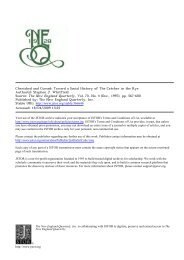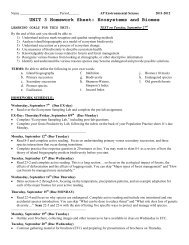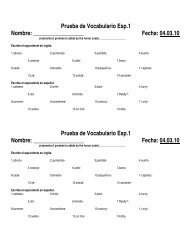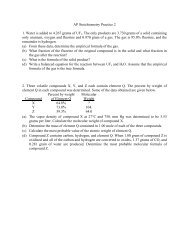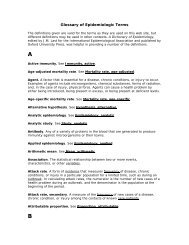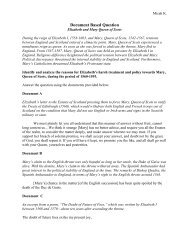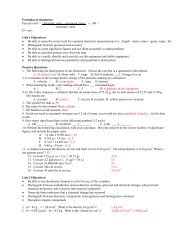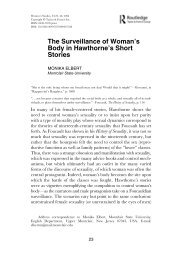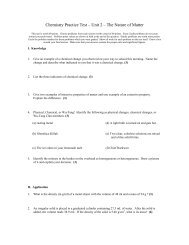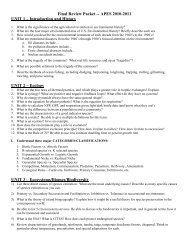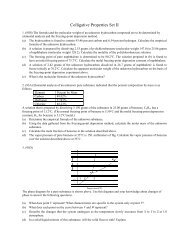Stoichiometry Unit Review Sheet Name
Stoichiometry Unit Review Sheet Name
Stoichiometry Unit Review Sheet Name
You also want an ePaper? Increase the reach of your titles
YUMPU automatically turns print PDFs into web optimized ePapers that Google loves.
<strong>Stoichiometry</strong> <strong>Unit</strong> <strong>Review</strong> <strong>Sheet</strong><br />
<strong>Name</strong> _______________________<br />
Be able to<br />
Balance equations<br />
Calculate the molar mass/molecular weight/formula mass of a substance<br />
Predict products of an ionic reaction and write a balanced net ionic equation<br />
Do mass-mass (and other) stoichiometry problems<br />
Do limiting reagent problems<br />
Do percent composition problems, including combustion analysis problems<br />
Calculate percent yield for a reaction.<br />
Predict products of a reaction based on the reaction type.<br />
Balancing equations:<br />
1. _____FeTiO 3(s) + _____Cl 2(g) + _____C (s) _____FeCl 2(s) + _____TiO 2(s) + _____CO 2(g)<br />
2. _____CH 3 CH 2 CHO (l) + _____O 2(g) _____H 2 O (g) + _____CO 2(g)<br />
3. _____Al 4 C 3 + _____H 2 O _____Al(OH) 3 + _____CH 4<br />
Classify the equations above as single displacement, double displacement, synthesis, decomposition or<br />
combustion.<br />
Predicting Products: Write balanced equations for the following reactions:<br />
1. The synthesis of lithium nitride from its elements.<br />
2. A double displacement reactions between aluminum hydroxide and nitric acid.<br />
3. The combustion of hexane (C 6 H 14 ).<br />
<strong>Stoichiometry</strong> Problems:<br />
1. Determine the number of liters of oxygen gas (at STP) required to react completely with 3.86 liters of hydrogen<br />
gas by the following reaction:<br />
H 2(g) + O 2(g) H 2 O (g)<br />
2. A double replacement reaction between barium chloride and sodium carbonate produces a white solid that does<br />
not dissolve in water. How many grams of this barium carbonate are produced by the complete reaction of<br />
197.45 g of barium chloride<br />
Limiting Reagent Problems:<br />
1. How many grams of zinc chloride are produced when 5.57 g of zinc is added to 1.53 g of HCl<br />
2. Using the same reaction as above, what volume of hydrogen gas is produced if 14.3 g of Zn is added to<br />
36.5 g of HCl<br />
Percent Yield:<br />
1. You do the reaction from question 1 above (“<strong>Stoichiometry</strong> Problems”) and you isolate 1.78g of ZnCl 2 .<br />
What is your percent yield<br />
2. You do the reaction from question 2 above (“<strong>Stoichiometry</strong> Problems”) and you isolate 4.42 L of H 2 . What<br />
is your percent yield
<strong>Stoichiometry</strong> <strong>Unit</strong> <strong>Review</strong> <strong>Sheet</strong><br />
<strong>Name</strong> _______________________<br />
Balancing equations:<br />
1. ___2__FeTiO 3(s) + __2___Cl 2(g) + _____C (s) ___2__FeCl 2(s) + __2___TiO 2(s) + _____CO 2(g)<br />
2. ___2__CH 3 CH 2 CHO (l) + ___9__O 2(g) ___6__H 2 O (g) + __6___CO 2(g)<br />
4. _____Al 4 C 3 + ___12__H 2 O __4___Al(OH) 3 + __3___CH 4<br />
Classify the equations above as single displacement, double displacement, synthesis, decomposition or<br />
combustion.<br />
Predicting Products: Write balanced equations for the following reactions:<br />
1. The synthesis of lithium nitride from its elements.<br />
6 Li + 3 N 2 2 Li 3 N<br />
2. A double displacement reactions between aluminum hydroxide and nitric acid.<br />
H + + NO 3 - + Al 3+ + OH - HOH<br />
3. The combustion of hexane (C 6 H 14 ).<br />
2C 6 H 14 + 19O 2 12CO 2 + 14H 2 O<br />
<strong>Stoichiometry</strong> Problems:<br />
3. Determine the number of liters of oxygen gas (at STP) required to react completely with 3.86 liters of hydrogen<br />
gas by the following reaction:<br />
2H 2(g) + O 2(g) 2H 2 O (g)<br />
3.86 1 <br />
22.4 <br />
1 <br />
2 <br />
22.4 <br />
1 <br />
1.93 <br />
1. A double replacement reaction between barium chloride and sodium carbonate produces a white solid that<br />
does not dissolve in water. How many grams of this barium carbonate are produced by the complete<br />
reaction of 197.45 g of barium chloride<br />
Ba 2+ + Cl - + Na + + CO 3 -2 BaCO 3<br />
197.45 1 <br />
208.236 <br />
1 <br />
1 <br />
197.3392 <br />
1 <br />
187.12 <br />
Limiting Reagent Problems:<br />
1. How many grams of zinc chloride are produced when 5.57 g of zinc is added to 1.53 g of HCl<br />
Zn + 2HCl ZnCl 2 + H 2<br />
1 <br />
5.57 <br />
65.409 1 <br />
1 136.32 <br />
11.6 <br />
1 <br />
<br />
1 <br />
1.53 <br />
36.461 1 <br />
2 136.32 <br />
. <br />
1 <br />
<br />
(the LR is the reagent that produces the least amount of product)
<strong>Stoichiometry</strong> <strong>Unit</strong> <strong>Review</strong> <strong>Sheet</strong><br />
<strong>Name</strong> _______________________<br />
2. Using the same reaction as above, what volume of hydrogen gas is produced if 14.3 g of Zn is added to<br />
36.5 g of HCl<br />
1 <br />
14.3 <br />
65.409 1 <br />
1 22.4 <br />
. <br />
1 <br />
<br />
1 <br />
36.5 <br />
36.461 1 <br />
2 22.4 <br />
11.2 <br />
1 <br />
<br />
Percent Yield:<br />
1. You do the reaction from question 1 above (“<strong>Stoichiometry</strong> Problems”) and you isolate 1.78g of ZnCl 2 .<br />
What is your percent yield<br />
% <br />
<br />
1.78 <br />
2.86 62.2%<br />
2. You do the reaction from question 2 above (“<strong>Stoichiometry</strong> Problems”) and you isolate 4.42 L of H 2 . What<br />
is your percent yield<br />
% <br />
<br />
4.48 <br />
4.90 90.2%




